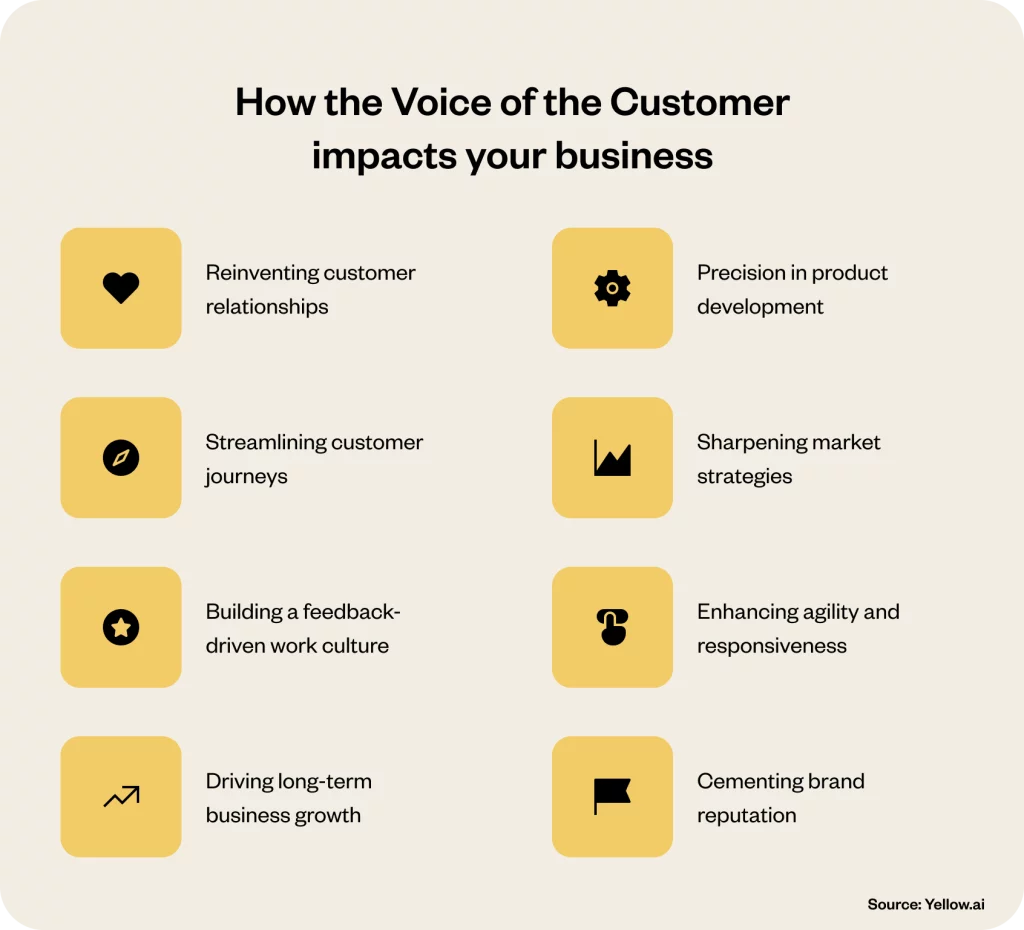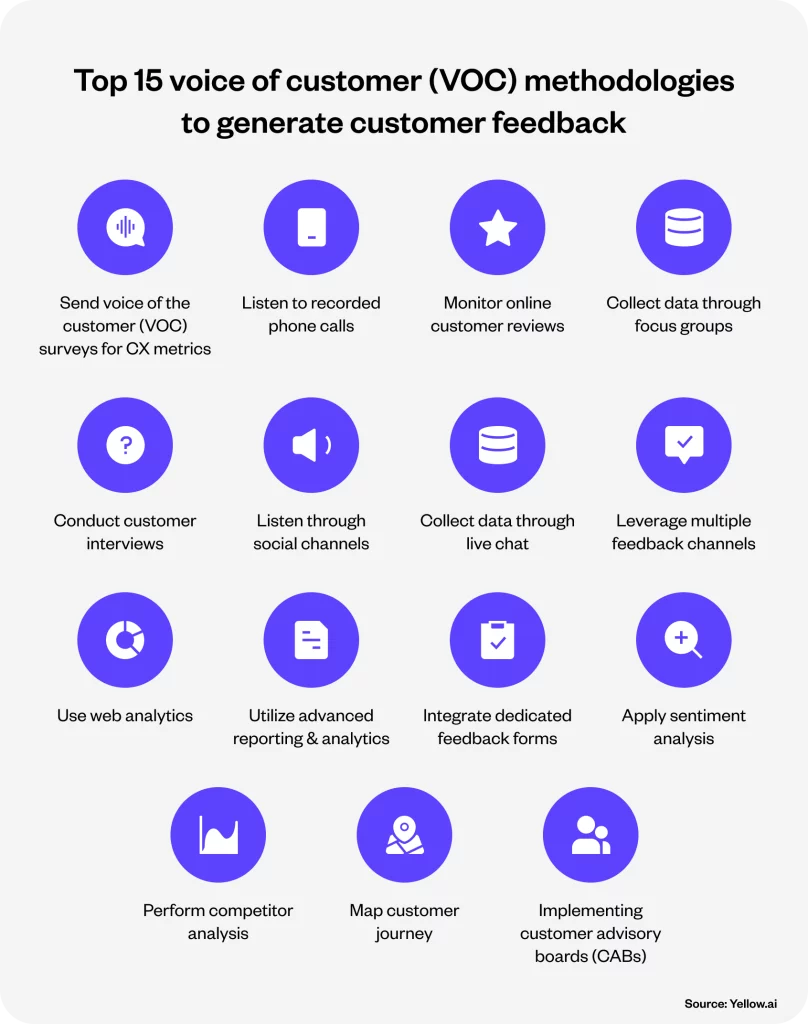Executive summary
Customer feedback shapes the fate of businesses in today’s era. Hence, understanding the ‘Voice of the Customer’ (VOC) is pivotal. This blog aims to explain VOC and its strategic importance in business growth. We will explore the benefits of VOC, from boosting customer satisfaction to fostering innovation and reducing costs. Additionally, this blog covers practical methodologies for capturing customer feedback, offering insights into developing a VOC strategy that aligns with business objectives and enhances customer experiences.
Today’s marketplace is a bustling digital world, and the ‘Voice of the Customer’ (VOC) resonates louder than ever. It is becoming a guiding light for businesses seeking success. Imagine navigating through various customer opinions, each as a valuable compass pointing toward what truly matters to your clientele. VOC is more than just gathering feedback. It’s about unlocking insights that can transform your products, services, and overall customer experience.
Gone are the days when businesses dictated the narrative. Today’s market leaders are in a constant, dynamic dialogue with their customers. It’s a world where a single online review or social media post can shape perceptions and influence decisions. With an estimated $83 billion lost annually by U.S. enterprises due to poor customer experiences, understanding and integrating the VOC has become more than a best practice. For businesses, it’s a survival strategy in the competitive landscape of customer satisfaction and loyalty.
Related must-reads:
- 12 Customer service metrics to measure in 2024
- Should your business outsource customer service?
- How can customer journey maps improve customer experiences?
- 10 Great customer service experience examples in 2024
What is the Voice of the Customer (VOC)?
Voice of the Customer (VOC) is a detailed process of capturing customer’s expectations, preferences, and aversions. VOC is a strategic tool that enables businesses to deeply understand the customer mindset, gathering rich insights that go beyond surface-level feedback. This process is integral to shaping products, services, and experiences that resonate deeply with the target audience.
Think of VOC as a conversation, a continuous dialogue where businesses listen intently to what their customers are saying, be it praise, concerns, or suggestions. Besides direct interactions, this exchange extends to capturing feedback from various channels – social media comments, survey responses, and customer service interactions. It even includes indirect feedback like online reviews and forum discussions. VOC is about understanding the ‘why’ behind customer behaviors and decisions and decoding the language of customer satisfaction and loyalty.
Today, customer expectations are higher than ever, and VOC is no longer optional. It’s a critical component of a successful business strategy. Implementing a robust VOC program can transform data into actionable insights. By leveraging advanced tools like text analytics and sentiment analysis, businesses can dissect customer feedback, identifying patterns and themes that offer a window into customer needs and desires.
The power of VOC lies in its ability to bridge the gap between customer expectations and their actual experiences. It helps businesses visualize customer-perceived value, which is directly linked to higher retention rates and increased sales. For instance, when a customer perceives high value in a product or service, they’re more likely to become a repeat customer and even a brand advocate.
Benefits of understanding the voice of the customer (VOC)
Understanding and integrating the Voice of the Customer into your business model is a comprehensive strategy that touches every aspect of your organization. This deep dive into the psyche of your customers can unlock transformative benefits for your organization.

Let’s explore these advantages:
1. Enhanced customer satisfaction
VOC is a commitment to hear your customers genuinely. When a business listens and responds to feedback, customer satisfaction skyrockets. It goes beyond resolving complaints; it’s about making the customer feel valued and understood. A satisfied customer is more likely to return and recommend your services, creating a cycle of positive engagement and loyalty.
2. Improved product quality
VOC offers an authentic perspective on your products. By analyzing customer feedback, you can pinpoint specific areas for improvement or innovation. This process leads to a product evolution that’s closely aligned with what the market genuinely needs and wants. That elevates the overall quality and appeal of your offerings.
3. Increased market relevance
Staying relevant in a rapidly evolving market is crucial. VOC provides real-time insights into evolving customer preferences and industry trends. By continuously adapting to these insights, your business remains competitive and relevant. Moreover, it ensures that your offerings resonate with current and prospective customers.
4. Better customer experience
VOC is a roadmap to an exceptional customer experience. By understanding the customer journey through their eyes, you can identify friction points and areas of delight. This knowledge allows for a more targeted approach to customer experience enhancements, ensuring a seamless and enjoyable interaction at every touchpoint.
5. Informed decision-making
VOC turns customer feedback into actionable data, guiding decision-making across various business facets. This data-driven approach reduces guesswork and aligns business strategies with what customers actually need and expect, leading to more effective and impactful decisions.
6. Enhanced innovation
Leveraging VOC in your innovation process ensures that new products, services, or features are creatively exciting and also deeply relevant to your customer base. It introduces an innovation culture that’s grounded in real-world needs and expectations. As a result, it enhances the potential for breakthrough developments.
7. Reduced costs
Understanding VOC helps in identifying inefficiencies and areas of waste. By addressing these areas, you can streamline operations, optimize resource allocation, and ultimately reduce costs. This financial prudence impacts the bottom line positively and also allows for reallocating resources to areas that drive growth.
8. Stronger brand loyalty
VOC fosters a deeper, more meaningful connection with your customers. When customers see their feedback being acted upon, it builds trust and loyalty. This emotional connection turns customers into brand ambassadors, who are invaluable for organic growth and market penetration.
9. Effective risk management
VOC serves as an early warning system for potential market shifts or customer discontent. By proactively addressing these issues, you can mitigate risks before they escalate, safeguarding your brand’s reputation and market position.
10. Data-driven culture
Embracing VOC instills a culture where decisions are based on complex data rather than intuition. This culture empowers your team at all levels to make customer-centric choices, fostering an environment where every action is taken with the customer’s best interest in mind.
How the Voice of the Customer impacts your business?
Integrating the Voice of the Customer (VOC) into your business framework is a transformative approach that reshapes how you engage with your market.

Here’s an in-depth look at the impact of a well-executed VOC strategy:
1. Reinventing customer relationships:
VOC redefines how businesses interact with their customers. It’s about forging a connection that goes beyond transactions. When customers see their input valued and implemented, it deepens their connection with the brand, turning them into loyal advocates of your services.
2. Precision in product development:
Feedback-driven product development leads to offerings that are finely tuned to meet customer desires and solve their specific problems. This targeted approach to innovation satisfies existing customers and also attracts new ones, looking for solutions that truly meet their needs.
3. Streamlining customer journeys:
VOC insights enable businesses to map out and refine the customer journey. It eliminates pain points and enhances satisfaction. This optimization leads to smoother interactions at every touchpoint, creating a consistently positive experience that boosts brand perception.
4. Sharpening market strategies:
By harnessing VOC data, businesses gain a laser-focused understanding of their market segment. It allows for the creation of highly targeted marketing strategies that resonate strongly with the intended audience, ensuring better engagement and higher conversion rates.
5. Building a feedback-driven work culture:
Incorporating VOC into the business ethos cultivates a feedback-driven work culture. Employees become more attuned to customer needs and expectations. It also allows for a shared commitment to delivering excellence and innovation in their respective roles.
6. Enhancing agility and responsiveness:
VOC equips businesses to be more agile and responsive to market changes. By keeping a finger on the pulse of customer sentiment, businesses can quickly adapt to shifting trends and preferences, maintaining relevance in a dynamic market.
7. Driving long-term business growth:
Ultimately, the consistent application of VOC insights contributes to sustainable business growth. Through improved customer retention, enhanced product offerings, and optimized operational processes, businesses see a tangible impact on their bottom line.
8. Cementing brand reputation:
A business that listens and acts on customer feedback is seen as customer-centric and trustworthy. This reputation for valuing customer input goes a long way in cementing a positive brand image in the market.
What is the Voice of Customer methodology?
The Voice of Customer (VOC) methodology enables businesses to understand and enhance customer experiences. It is a systematic approach to capturing customer feedback, deciphering their expectations, and aligning business strategies accordingly. Besides collecting data, VOC also distills meaningful insights from customer interactions. Furthermore, it leverages these insights to drive improvements across various business facets.
How does it work?
The VOC methodology involves several steps, each tailored to gather specific types of customer feedback and insights.
The process begins with identifying key questions and objectives for the VOC program. These questions are foundational, directing the focus of the feedback collection. They could range from understanding the reasons behind a drop in repeat purchases to gauging customer loyalty and identifying areas for product enhancement. The objectives set for the VOC program guide the type of data to be collected and the methods to be employed.
Once the questions and objectives are clear, the next step is to choose appropriate techniques for data collection. It could involve deploying customer surveys, conducting interviews, hosting focus groups, or analyzing social media interactions.
Each method offers unique insights and caters to different aspects of the customer experience. For instance, surveys are excellent for quantitative data, while interviews and focus groups provide qualitative depth.
Choosing the technique
The choice of technique also depends on the specific area of business or customer interaction you wish to evaluate. If the aim is to assess the performance of the customer service team, then surveying customers who have recently interacted with the service department would be apt. Similarly, for product improvement, gathering feedback from users who have recently purchased or used the product can offer actionable insights.
It’s essential to note that the VOC methodology is not a one-time exercise but an ongoing process. Continuously gathering and analyzing customer feedback ensures that businesses stay attuned to changing customer needs and preferences. This ongoing process allows businesses to set a performance baseline, measure improvements over time, and make iterative enhancements to their offerings.
Top 15 voice of customer (VOC) methodologies to generate customer feedback
The methodology for capturing the Voice of the Customer (VoC) is a critical aspect for any business working towards understanding and improving its customer experiences. Each methodology provides unique insights, and using a combination of them can yield a comprehensive understanding of customer sentiment. Here’s a detailed guide on the top 15 VoC methodologies:

1. Send voice of the customer (VOC) surveys for CX metrics
a. Net Promoter Score (NPS) to measure customer loyalty
Imagine asking your customers just one question: “On a scale of 0-10, how likely are you to recommend us to others?” That’s your NPS. It’s straightforward and tells you how many of your customers are true advocates of your brand. For example, a coffee shop might find that customers who love their unique flavors are more likely to bring friends, indicating high NPS scores.
Related read: Net Promoter Score (NPS): The definitive guide for businesses
b. Customer satisfaction (CSAT) score to measure satisfaction
CSAT is all about asking your customers to rate their satisfaction with your service or product. It’s usually a simple scale, like 1 to 5. Let’s say a software company uses CSAT to gauge reactions to its new update. A score of 4 or 5 indicates users are happy, whereas lower scores signal the need for improvement.
c. Customer effort score to measure customer’s perceived effort
CES measures how easy it is for your customers to do business with you. Ask them, “How easy was it to handle your issue?” For instance, a retail store might find that customers appreciate their quick checkout process, reflected in high CES scores.
Related read: What is Customer Effort Score and how to improve CES?
2. Listen to recorded phone calls
Listening to recorded customer calls is a goldmine of unfiltered customer feedback. By deeply analyzing recorded calls, businesses can get nuanced insights. These insights can range from emotional cues to specific feedback about products or services. It’s a chance to hear your customer’s voice in its most unfiltered form, offering information to enhance customer interactions and rectify issues that may not surface in structured surveys.
3. Monitor online customer reviews
Online reviews are a public testament to a company’s performance. They are like public forums where customers voice their delight and grievances. Monitoring these reviews is crucial for understanding the public perception of your brand. It’s an opportunity to address concerns, acknowledge compliments, and showcase your commitment to customer satisfaction.
This method also offers a panoramic view of customer sentiment, which is invaluable for shaping your business strategies.
4. Collect data through focus groups
Focus groups provide an interactive platform for in-depth customer feedback. They are just like the roundtables of customer feedback. In this controlled environment, a diverse group of customers can discuss, debate, and provide insights into their experiences with your products or services.
This methodology offers depth and context to customer feedback, revealing the ‘why’ behind customer opinions. It’s beneficial for testing new concepts, understanding customer perceptions, and identifying unmet needs.
5. Conduct customer interviews
Direct interviews with customers are an invaluable tool for gathering in-depth feedback. They offer a platform for detailed discussions, allowing customers to share their experiences, expectations, and suggestions. This personalized approach yields rich qualitative data and also strengthens customer relationships. It also shows customers that their opinions are valued and considered.
6. Listen through social channels
Social media platforms are where customers freely express their opinions. It is a dynamic and immediate channel for customer feedback. Monitoring these channels is vital for capturing real-time feedback and engaging with customers in their natural digital habitat. This approach helps in understanding prevailing sentiments about your brand and offers a direct line to address customer concerns swiftly and publicly.
7. Collect data through live chat
Live chat interactions provide immediate insights into customer needs and preferences, which often occur at critical decision points in the customer journey. Analyzing these interactions can provide immediate insights into customer needs, preferences, and pain points. This real-time data is instrumental in enhancing customer service strategies and improving the overall user experience on your digital platforms.
8. Leverage multiple feedback channels
Employing a multi-channel approach to gather feedback ensures a well-rounded understanding of customer experiences. Each channel, from in-store feedback forms to online surveys and social media interactions, caters to different customer segments and preferences.
Besides enriching your data pool, this comprehensive strategy also accommodates varied customer communication styles, ensuring no voice goes unheard.
9. Use web analytics
Web analytics provide a behind-the-scenes look at how customers interact with your online presence. From tracking user navigation paths to understanding engagement levels on specific pages, this methodology offers crucial insights into online customer behavior. It’s a strategic tool for optimizing your website’s user experience and tailoring content to meet customer needs and preferences.
10. Utilize advanced reporting & analytics
Advanced reporting and analytics turn raw data into actionable insights. This methodology involves sophisticated data analysis to unearth trends, patterns, and correlations within customer feedback. It’s a powerful approach for driving strategic improvements across products, services, and customer experiences.
11. Integrate dedicated feedback forms
Customized feedback forms embedded in various customer touchpoints provide a structured avenue for gathering specific feedback. Whether it’s a post-purchase survey or a product review form, these tools enable businesses to collect valuable insights systematically. They are essential for capturing the nuances of customer experiences and shaping targeted improvements.
12. Apply sentiment analysis
Sentiment analysis, powered by advanced natural language processing (NLP), digs into the emotional undertones of customer feedback. It categorizes opinions into positive, negative, or neutral. Hence, it offers a deeper understanding of customer sentiments. This technology-driven approach is crucial for tailoring marketing messages, improving product features, and enhancing overall customer engagement.
13. Perform competitor analysis
Understanding how your customers view your competitors is as crucial as understanding their opinion of you. Competitor analysis involves evaluating customer feedback on your rivals to identify their strengths and weaknesses. This strategic intelligence helps position your offerings more effectively and capitalize on market opportunities.
14. Map customer journey
Mapping the customer journey offers a holistic view of the customer experience. Journey mapping involves creating a comprehensive visual narrative of the customer’s experience with your brand. It helps identify key touchpoints and moments of truth that shape customer perceptions. This methodology is a strategic tool for visualizing the customer’s path, from awareness to loyalty, and pinpointing opportunities for enhancing the overall experience.
Related read: Customer touchpoints – Mapping customer journey and improving CX
15. Implementing customer advisory boards (CABs)
Customer Advisory Boards (CABs) are forums where select customers provide ongoing feedback and guidance. Forming a customer advisory board brings together a diverse group of customers to provide ongoing, in-depth feedback. This collaborative approach offers continuous insights into customer preferences and behaviors. It’s an invaluable method for aligning your business strategies with customer needs, fostering loyalty, and driving continuous improvement.
Begin your journey with Yellow.ai
Your path to superior customer service begins here.
Embarking on a journey to understand and cater to your customer’s needs is both crucial and transformative for any business. The right tools are crucial for harnessing the power of the Voice of the Customer (VOC). That is where Yellow.ai steps in, offering industry-leading, cutting-edge Conversational AI solutions.
Automated feedback analysis: Yellow.ai’s chatbots can automatically analyze customer feedback from various channels, providing businesses with quick and insightful analysis. It helps in understanding customer sentiments and preferences in real-time.
Personalized responses: Leveraging AI, Yellow.ai chatbots can offer customized interactions based on individual customer histories and preferences, enhancing the customer experience and building loyalty.
Scalable customer engagement: Yellow.ai chatbots can handle high volumes of customer interactions simultaneously, ensuring that no customer feedback is overlooked and every voice is heard, making the VOC process more inclusive and comprehensive.
Real-time insights: With Yellow.ai, businesses gain access to real-time insights from customer interactions, enabling them to make swift, informed decisions based on current customer feedback and trends.
Yellow.ai’s chatbot technology can be a powerful tool for businesses to capture and utilize VOC data effectively. It leads to more customer-centric strategies and improved customer experiences.
So, don’t just listen to your customers—engage with them meaningfully. Book a demo with Yellow.ai today and commence your journey towards superior customer experiences.
Ready to revolutionize your customer support experience?

The final thoughts
The VOC journey is exciting and challenging but immensely rewarding. It’s about crafting a narrative that resonates with your customers, turning their feedback into the guiding light of your business’s growth. Remember, VOC is more than just about collecting data; it’s about weaving that data into the very fabric of your decision-making process.
Remember, the journey of integrating VOC into your business is an evolving one. It’s a commitment to adapt and align with your customer’s changing needs continuously. It is this journey that keeps businesses vibrant, relevant, and ahead of the curve. As we wrap up, consider this not as an end but as a beginning to a more engaged, customer-focused, and innovative business journey.
Frequently asked questions (FAQs)
What is the voice of the customer technique?
The voice of the customer (VOC) technique is a strategic approach that focuses on understanding customers’ needs, expectations, and preferences. It involves collecting and analyzing feedback to gain insights into customer experiences, aiding in making informed business decisions.
What is the VOC process?
The VOC process is a systematic approach to capturing, analyzing, and acting on customer feedback. It includes identifying key customer touchpoints, gathering data through various methods like surveys and interviews, analyzing the information, and implementing changes to improve customer experiences.
What is a VOC example?
A typical example of VOC is a company conducting customer satisfaction surveys to gauge the effectiveness of its new product launch. The feedback collected helps the company understand customer perceptions and make necessary adjustments to the product or marketing strategy.
What are the 4 steps of VOC?
The four steps of VOC are:
1) Identifying key customer touchpoints
2) Gathering customer feedback through various methods
3) Analyzing the feedback to uncover trends and insights
4) Implementing improvements based on the analysis to enhance customer experiences.
How do you create a voice of customer program?
To create a voice of customer program, start by defining clear objectives and identifying customer touchpoints. Develop a method for collecting feedback, such as surveys, interviews, or focus groups. Analyze the data to find actionable insights and then implement changes to improve customer experiences. Continually monitor and adjust the program to ensure it stays relevant and effective.
What is the purpose of the voice of the customer program?
The purpose of a voice of the customer program is to deeply understand customer needs and preferences, thereby enhancing customer experiences, driving business growth, and building customer loyalty. It provides a framework for businesses to align their products, services, and strategies with customer expectations.
















